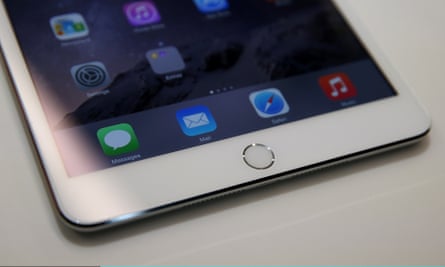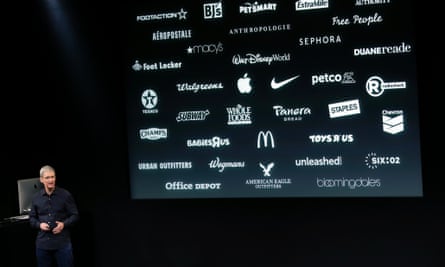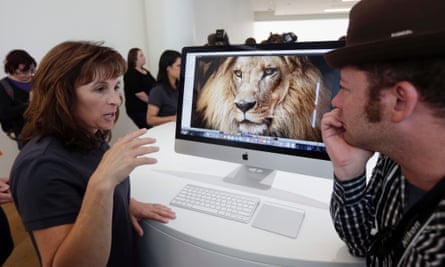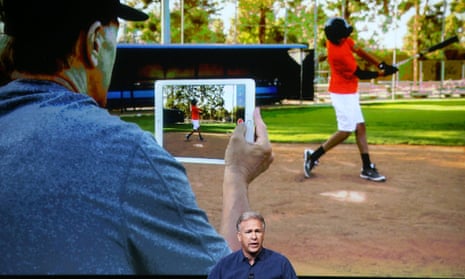The iPad event on Thursday looked uneventful: after all, what’s exciting about speed-bumped iPads getting last year’s features (the TouchID fingerprint unlock system and slow-motion cameras) and a hefty downward shove on the price of last year’s?
The Guardian’s product and service reviews are independent and are in no way influenced by any advertiser or commercial initiative. We will earn a commission from the retailer if you buy something through an affiliate link. Learn more.
Underneath, though, this was a “dog-whistle” event. “Dog-whistle politics” is the sort where a politician appeals to a particular part of the electoral base, using words and phrases that their audience will react to, but which leaves everyone else cold. (It’s often used of right-wing politicians: phrases about “jobs” tend to mean “immigration”, for example.)
Apple did something different: these are dog-whistle features. But the whole part of the presentation devoted to the iPad had dog-whistle moments. The iPad’s slow-motion feature was shown off with an athlete jumping into a sandpit - not, as Apple slo-mos have in the past used, a domestic scene such as a wet dog shaking itself. A professional photographer was shown talking about working with the iPad.
The iPad, goes the dog-whistle message, is for work, not play.
TouchID: down to business

The TouchID addition is important for people who use iPads in businesses, especially the giant “enterprises” where thousands of devices might be deployed. When I mentioned on Twitter that TouchID looked useful on the new iPads, the responses came thick and fast from people who don’t want to have to type their long IT department-mandated passwords into a screen, but would rather unlock them with the touch of a finger.
“TouchID [is] very important in enterprise for mobile workforces, particularly in customer-service scenarios,” responded Tim Edwards of Dootrix, an enterprise software development consultancy. Long passphrases are the enemy of quick interaction with a customer, he explained: “Fumbling around with a strong passcode doesn’t cut it for a quick customer interaction, especially in travel.”
Evernote links to TouchID, as can any custom app for enterprise – the software hooks (APIs) are available to any app that requires authentication. 1Password, which acts as a master vault for passwords for apps and websites, also integrates with it.
The sense of relief from iPad users in business was (to me) surprisingly palpable on Twitter after the announcement; in retrospect it’s understandable that pressing a finger looks far more desirable than typing a long, hard-to-remember code. “[My] work Exchange policy mandates a long password - will be brilliant for me,” remarked Richard Harnwell on Twitter.
That’s certainly going to be important for Apple. With iPad sales having fallen year-on-year for the past nine months as the tablet market bifurcates, it needs to look to vertical markets and business for fresh growth where price isn’t so important.
Apple Pay: the quiet revolution

NFC (Near-field communication) has been available in Android phones since early 2011, since when the installed base of Android phones has gone from around 50m worldwide to more than a billion, and the US user base from about 18m to over 90m.
In that time, Google Wallet, launched in May 2011, has had 20m downloads - though I’ve been told by several sources in the US financial services industry that only about one-tenth of those actually use their phones for NFC payments in stores; in other words, 2 million people, at best, making occasional use of their phones to pay for goods in store.
Google Wallet and NFC on Android phones has got nowhere, basically. It has struggled to sign up merchants or banks, and both carriers and merchants tried to launch their own competing NFC payment systems, Softcard and MCX, which have had little success either because they’re all at odds with each other.
Now, though, Apple is steamrollering in. Having already signed up a number of banks and merchants for its announcement on 9 September, Tim Cook said on Thursday that another 500 banks have come forward to get involved in Apple Pay, as well as a number of merchants (including Starbucks, which has had its own payment system going for some time).
“We believe ApplePay is going to change things profoundly,” Tim Cook said. The advantage that Apple has is that ApplePay will have a really big merchant ready to use it straight away: all of Apple’s stores, which number more than 250 in the US. Given that Apple has surely already sold at least 2m new iPhones in the US (and perhaps more like 5m), it’s highly likely that the value and volume of NFC transactions through Apple’s Stores in the US in the next two months will exceed that across the US in the previous ten months of this year.
Sounds hyperbolic? Yes, but that’s how Apple gets a sense for a market. When it launched the iTunes Music Store in April 2003, early expectations (even inside) were that it would sell a million songs in its first year: the Music Store was Mac-only, US-only, and most people weren’t on broadband. (And they were all on desktops or laptops.)
Instead, it passed that milestone in its first week; by July 2004 (having been released for Windows in October 2003) it had sold 100m.
One can argue that there aren’t many NFC-capable tills in the US, which is largely still stuck in the card-swiping dark ages; chip-and-pin, as used in the UK and the rest of Europe, isn’t yet mandatory.
But a series of terrible hacks which have given millions of credit card details to hackers because companies stored them following transactions means that the US banks have finally had enough. They are making chip-and-pin (also known as EMV) mandatory: by October 2015 any business that doesn’t have EMV implemented will have to bear the brunt of fraud, rather than being able to pass it to the banks, as they can now.
That means tills are being updated, and NFC payment capability is an inexpensive “nice to have”. Apple executives have indicated to me that they think that their timing on this is just right - and in business, it’s often timing that matter more than just technology.
By linking the payments to authentication through TouchID, Apple is willing to bear the cost of any fraud - but at the lower rate of “card present” (ie, the real card was shown in the transaction) rather than “card not present” (such as a telephone purchase). Google Wallet, on the other hand, has to assume a “card not present” fee - and its interface is a lot less smooth than Apple Pay.
Even so, that so many more merchants and banks want to participate in Apple Pay means it will drive NFC adoption. That will have benefits for Android users too in the US and beyond. At the end of September it emerged that Apple has poached Mary Harris, the head of mobile at Visa Europe, to lead its ApplePay efforts in Europe. Expect to see that before you see Google Wallet extended beyond the US.
New iMacs? Where are the touch screens?

A good portion of Apple’s presentation on Thursday was given over to a new iMac, its “consumer desktop” computer, which will have a super-high-definition screen described as “5K” quality.
The picture quality is extremely good - but it’s priced at a point where only a tiny percentage of users will be able to afford one, though they will be able to edit their photos and videos in amazing quality - to then be viewed on tiny mobile screens over bandwidth-compromised connections.
Some might be wondering why Apple isn’t instead getting into two-in-one devices (with detachable keyboards, such as the Surface Pro), since those are the part of the Windows PC business showing growth while conventional desktop and laptop either dwindles or stumbles along.
Tim Cook doesn’t sound as though he’s keen to introduce a 2-in-1, though; as he ranked the iPad’s sales in the four quarters starting March 2013 against those of the four largest PC makers (Lenovo, HP, Dell and Acer) he mentioned that the numbers included “laptops, desktops, 2-in-1s, toaster-refrigerators” in a reference to his dismissive take on the Surface in April 2012.
Apple doesn’t seem prepared to roll out a toaster-fridge just yet (though it’s probably a good bet that there’s one in the design labs). But it doesn’t have any good reason to. Its conventional PC sales are still going up year-on-year even as the rest of the business goes down; over the 12 months to the end of September, Apple’s PC sales have risen by an average 12.6% year-on-year, while those of Windows PC have fallen by 5.4%.
If you exclude Apple sales, those of Windows PCs have fallen year-on-year for nine quarters in a row, averaging 7.6% per quarter according to IDC’s figures. Apple has had growth for five quarters of those nine, averaging 1% growth per quarter. And it mops up a good chunk of the profit in the business - those iMacs are expensive at $2,499, but each one sold will probably bring in more profit than 10 sub-$400 rock-bottom PCs.
So for Apple, the PC business is still a good news story, even if the iPad has stalled. But to the question of “where are the touchscreens computers?”, one has to return back to the top of this piece. Apple already makes a touchscreen computer. It calls it the iPad.
Apple TV? Where? Why not?

The mystery in all of this - the huge, gaping hole - is the lack of an update to Apple TV, the set-top box which Tim Cook said in April is a billion-dollar business (through sales of devices and content). The worldwide installed base is about 20m. But it’s sadly limited: you can’t even get an iPlayer app for it.
The announcement on Wednsday by HBO that it will have a cable-free internet-streamed offering in 2015 looked for a moment like a glimpse of an aggressive move by Apple to get into the TV space. But no: Thursday brought nothing.
Third-party developers are straining at the leash to develop for the Apple TV: the TV set is still the prime real estate in the living room, and there’s now so much competition to be the internet’s avenue to the TV (look at Chromecast, Android TV - both from Google - along with the PlayStation, Xbox and even Wii, not to mention Roku) that it seems incredible Apple is not jumping in.
Yet it isn’t. Either it really can’t figure out TV, or it is waiting to tie in others like HBO to cable-free hookups. For developers, though, it’s hugely unsatisfactory. For users, AirPlay (beaming content from an iPad to the Apple TV) is good enough, but it’s never as good as having the content natively on the device.
It’s the dog whistle, stupid
To conclude, Apple is still confident about the iPad, even though the updates announced on Thursday really don’t look like much on paper. And it’s sending out the signals to those willing to listen: TouchID is here, Apple Pay is here, our PC business is getting stronger. Lots of people won’t hear it, or believe it. But Apple is in it for the long run.
- Charles Arthur’s travel and accommodation to Berlin was paid by Apple. Editorial is completely independent.

Comments (…)
Sign in or create your Guardian account to join the discussion